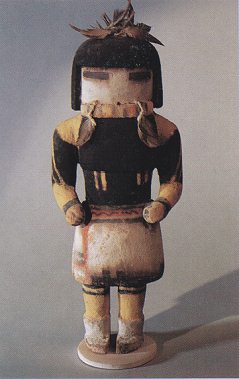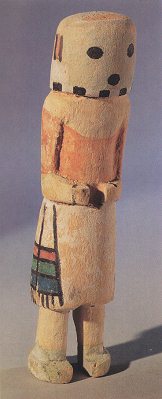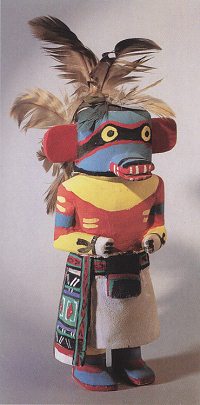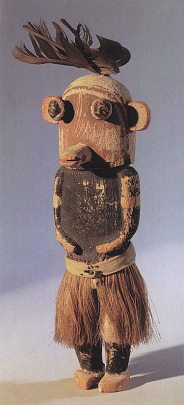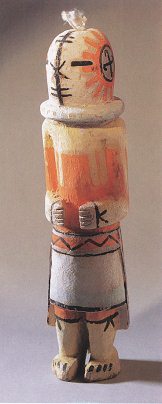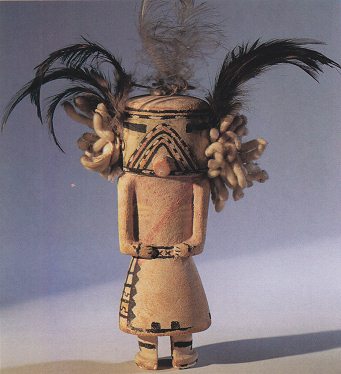North "American" Primary Nations Museum (North America Native Museum) Zurich
| Share: |
Facebook |
|
Twitter
|
|
|
|
from:
Prestel museum guide, text by Denise Daenzer and Tina Wodiunig: Native Museum of Zurich (orig. German: Indianermuseum Zürich / Indianermuseum der Stadt Zürich); Prestel edition; Munich, New York 1996; supported by Cassinelli Vogel foundation, Zurich, by MIGROS percent for culture, by Volkart foundation in Winterthur; ISBN 3-7913-1635-4
<Kachinas
["Mediator between humans and gods" - probably these were extraterrestrials respectively astronauts]
One of the mostly loved products of native handicrafts are the kachina figurines of Hopi primary nation. Kachinas are supernatural beings and can be considered as mediators between humans and gods [probably these were extraterrestrials respectively these were astronauts as they have appeared also in other cultures of today's Ecuador, Columbia or in Asia]. Kachinas are transmitting prayers of the natives for rain and fertility to the gods. At the other hand they also have a function of control and vigilance and are helping to men overcoming daily problems.
[This is exactly the thesis of Erich von Däniken: extraterrestrials came as a connection to the gods and teaching overcoming daily problems developing new solutions for agriculture and administration].
Kachinas with symbolic boards over the head
So called butterfly girl was also member of woman kachinas and of insect kachinas. On the third Mesa during kachina dances this kachina girl is personificated by a man with mask and in a woman's dress. On the other Mesas it is personificated by women dancing without mask. On the headboard "tablita" a sun and flowers and polliwogs can be seen. The butterfly girl is a symbol for fertility.
This kachina is a Hopi interpretation of a Zuñi kachina, called "Hemishikwe" by them. Since 19th century Hopi know this kachina. On the headboard "tablita"can be seen above three symbols for clouds, left and right stylized corn plants, and in the middle a rainbow. One can see this kachina during the ceremonies in early summer.
More examples of kachina figurines
Long hair kachina was also copied by the Hopi from the Zuñi because this kachina is very successful as a rainmaker and supporting the growing of the plants. The long and flat hair is symbol for falling rain, and the little eagle breast feathers on the head are symbol for clouds. Zuñi call this long hair kachina "Kokoshi".
"Hakto", wood carrying kachina, was first also in Zuñi primary nation and called "Yamuhakto". Hopi copied this kachina from about 1850 integrating it in their ceremonies, but only on the first Mesa. With this figurine the headboard is missing which normally have all "Hakto" kachinas.
Sky god kachina of Hopi primary nation is represented as a person by certain religious wise men in "Kiva" ceremonies. It's appearing in "Powamu" ceremony and in spring on all Mesas in mixed dances. This sky god is controlling the dangerous thunderstorms and rainstorms. But Sotuknangu is also an always winning warrior with much destructive force - but in spite of all this some Christianized Hopi are identifying it as God father. His symbol is the morning star.
First this kachina was in the Pueblos of Rio Grande and then reached also Hopi primary nation. Following the legend it is the personification of a historic Hopi rebel. It's said that after the Pueblo uprising in 1680 he was looking for protection in the villages at Rio Grande river hiding from the Spaniards. And later he got food and could return to his fighter group - the legend says.
Kachinas were the central element of ceremonial life in the Pueblos before the white imperialist came. According to the idea of Hopi primary nation they lived with the natives first. After committing a big mistake the kachinas left the villages retreating to San Francisco Mountains near Flagstaff. But kachinas are returning regularly to the Pueblos between winter solstice and mid of July. During this time most of the kachina dances are performed, on public locations or in secret locations of cultural societies, called "kivas". During the ceremonies the kachinas are entering the bodies of the masked men representing them: they let pour their spirit into the dancing natives, so the dancing men are kachinas at the end.
[Making kachina puppets with root wood and natural colors]
Kachina puppets - Hopi call them "tihu" - were carved and painted first by men during the rests between the ceremonies. Material was dried root wood of American poplar tree and colors of plants or mineral substances. During the ceremonies the dancers gave the puppets to the children, but not for playing but as objects for a kind of instruction. Using the colored puppets the children learnt from the beginning the meaning of the kachinas. In most of the villages their function also was a symbol of fertility. The kachina puppets were hooked on the wall or on a roof beam and were always present in Pueblo's daily life.
Today there are about 250 different kachina types. Their number is varying from village to village and is always changing again because there are always coming new kachinas and old ones are lost.
[Chief kachinas (very holy) and little kachinas (less holy)]
Basically there are two groups of kachinas to be distinguished: There are the great "chief kachinas", assigned to certain clans and rated as especially holy, and there are little kachinas having only little significance. "Chief kachinas" have absolutely distinctive remarks which are not allowed to be changed - but can be changed for commercial purposes (p.35).
Kachinas of second and large group have many variations and are ornamented with ears, beaks, snouts and so on because there are not fixed rules for representing them - to the contrary for "chief kachinas" the rules are fix. The little kachinas can represent
-- members of other villages or tribes
-- spirits of deads or even
-- Christian holy persons.
[Categories of kachina puppets]
There are many functions of kachinas and therefore it's possible to categorize them. Here are the most important categories:
-- ward kachinas controlling the ceremonies and working also as policemen and as soldiers;
-- cannibal kachinas (photo 8) helping natives educating discipline of their children
Chaveyo kachina in Hopi culture is an educating kachina being also member of the chief kachinas and the cannibal kachinas. During spring ceremonies this kachina can appear in all Pueblos where this kachina makes always trouble. Children and adults who were attracting bad attention during the year have to be aware to be scolded.
-- clown kachinas giving entertainment between the ceremonies, but at the same times also teaching the people and blaming them
-- runner kachinas (photo 6) challenging men for races;
This rattle kachina of Hopi primary nation is member of the runner kachinas. It's called rattle kachina because it's head is similar to a pumpkin rattle. Such pumpkin rattles are distributed to the children during Powamu and Niman ceremonies. On the temples of the head sun designs can be seen. During the ceremonies this kachina is holding a yucca rod in their hands beating the runners when they lost a footrace against her.
-- native kachinas (photo 4) representing neighboring ethnicities;
This is an old version of a kachina representing the Hopi neighbors of Navajo. The last time this kachina could be seen in 1914 in the village of Mishongnovi. During the circular dances it is singing in Navajo language. On the left and right side of it's head there are feather bushels and Hopi cotton. New form is different above all because the face is parted by a black vertical line parting the face into a green and a rust red half.
-- and at the end many different kachina groups representing plants and animals (photo 10).
Mountain sheep kachina of Hopi primary nation is member of animal kachinas and appears mainly in the circular dances. As all other vegetarian beings only eating plants it has the capacity of healing cramps and making rain.
The oldest known kachina group was recollected in the second half of 19th century and the puppets are very simple. There was taken a peace of wood and only some details are on them. This kachina type is made until today in the Eastern Pueblos at Rio Grande river yet.
[Selling kachina puppets from 1890 on - first off-standing arms]
At about 1890 the first kachinas were purchased and resold by merchants, and in about 1900 already the production of the first puppets began for commercial purposes. These kachina have got two stiff legs and basically are static in their form yet, but sometimes have got two off-standing arms already. But until the 1930s these puppets only were objects of recollectors and were sold cheap yet. Only after Second World War the demand got to be high and in the 1960s and 1970s there was a real kachina boom. Today these figurines - especially the early simple forms - get very high prices as art's objects of North America.
[Tourism and handicraft with adapted, "real" kachina puppets]
During the last past years [in the 1990s] the form of kachina puppets changed to be always more dynamic and real [resp. the form of the extraterrestrial astronauts was not conceived and they adapted the form to humans arbitrarily]. Most popular are nowadays the "Action Dolls" in a pose of dance being similar to real kachina dancers. They are on a socket on which the kachina's name and the name of the kachina's carver can be read. Carvers in former times never gave any lettering of their works. Their work was mostly for the shape and for the painting of the kachina face. Add to this the puppets had only some rare little feathers, bast, fabric or other materials. But Zuñi primary nation gave to kachina puppets little clothes in early times already.
Nowadays modern kachina figurines get always more and more ornaments, and there is even the creation of princess and Mickey Mouse kachinas. And always more commerce brings also a more and more industrial production and only painting is made by hand yet - for being sold as a native handicraft.
But aside of these series of puppets always exist yet the classic hand carved kachina puppets which are given to children during ceremonies and never lose their magic meaning (p.36).
^




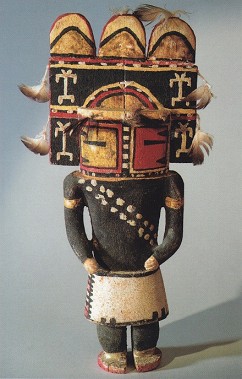
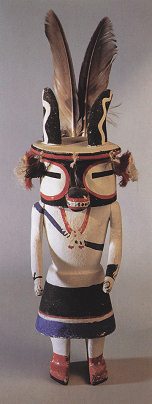
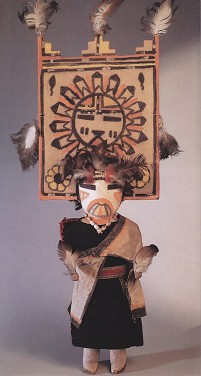
 Poli
Mana kachina, 1930 appr., kachina for fertility
(photo 1)
Poli
Mana kachina, 1930 appr., kachina for fertility
(photo 1)